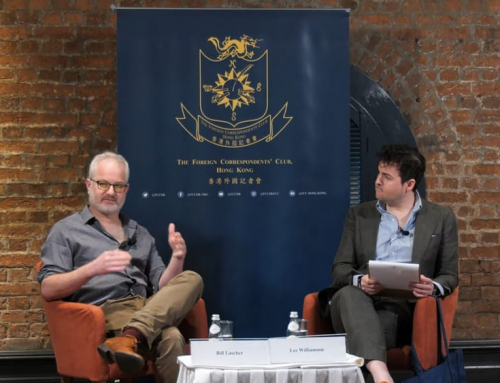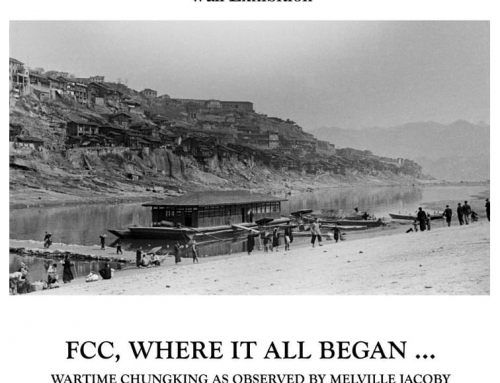Can common ground be found on the divisive issue of Tibet? First, it’s necessary to find out what the people involved think, and why.
Chinese-speaking journalist Annelie Rozeboom worked as a foreign correspondent in China for ten years. During that time she was able to interview numerous Tibetan people inside and outside Tibet, as well as Chinese and Western observers and the Dalai Lama himself. The focus of the interviews, which became a book, was on the life stories of these individuals. As they tell their stories, it becomes clear to the reader why they think the way they do. The book also shows how history washed over this remote kingdom and how the Tibetans and the Chinese came to take such opposing positions.
Waiting for the Dalai Lama: Stories from all sides of the Tibetan debate is available from April 2010. Here we print an excerpt.
Introduction: Pictures of the Dalai Lama
The old woman in front of the Jokhang temple shows two brown teeth. She mutters incomprehensibly and holds out her hand. Another beggar, I think. In Lhasa they follow you around; kids with home-made wooden musical instruments which they play for two seconds before asking for money; monks with a plastic bag full of change who want a contribution for their monastery, and now this old woman in front of the temple. Behind us, pilgrims throw themselves to the ground. First, they stand upright, hands crossed on their chests, and muttering prayers. Then they let themselves drop like planks. Their hands land on small rectangular pieces of cardboard, which slide forward producing scraping noises as their bodies fall.
I sigh and find an old five-mao note in my bag. According to the Lonely Planet, this is the acceptable amount. “Give just as much as the locals,” was the stern warning. “You don’t want beggars to think that Westerners give more.” But when I stuff the dirty note in her hand, the woman gives me a bewildered look. What am I doing wrong, I ask myself. Not enough? Has there been inflation? Then a man next to me starts laughing. “She asked you for a picture of the Dalai Lama and you gave her money,” he chuckles.
Have I started thinking like a Chinese? They also seem to be convinced that the Tibetans want money, while many of them just want their religious leader back. The day before my visit to the temple I listened to a monologue from a very nice, albeit rather boring, Chinese official working in Lhasa. It took him three hours to explain to me that Tibetans want riches and development. “It’s like that everywhere in the world and there is absolutely no reason why this would be different in Tibet,” he said.
He was partly right, I discovered. Of course the Tibetans want to develop. But they are also deeply religious, and if they had to choose between their faith and the Chinese plans for development, the Chinese wouldn’t stand a chance. The big problem is that the Tibetans were never given a choice. Ever since 1950, the year that the Chinese army invaded Tibet, the Chinese Communist party has promised development. The Chinese built roads and schools. The leaders from Beijing claim to have invested three billion dollars into the new “Autonomous Region” in the last thirty years. According to the Chinese press, this investment has paid off and Tibetan GDP has increased tenfold.
In exchange, the Tibetans gave up their independence and their cultural and religious traditions. The Chinese called this “the people’s liberation from feudal monasteries and rich landowners.” The region, which until then had been closed to foreigners, was governed by a religious and political leader, the Dalai Lama. After the invasion, the Dalai Lama tried to work together with the aggressors from Beijing. He sent a delegation, but the representatives were forced to sign a seventeen-point agreement. The document stipulated that Tibet from now on would be part of China, but Mao Zedong also promised the Tibetans freedom of religion and self-government.
It didn’t take long, however, before the Chinese authorities started to breach the conditions of their own agreement. When rumors started going around that the authorities were planning to kidnap the Dalai Lama, the religious leader fled to India. Eighty thousand followers decided to go with him. Together, they started a refugee community and a government in exile. Tibet’s second-in-command, the Panchen Lama, stayed behind. He tried to collaborate with the new authorities and ended up in jail. Then, in the 1960s, the Chinese brought their Cultural Revolution to Tibet. Thousands of monasteries and temples were destroyed. A million Tibetans lost their lives. Not all Tibetans fared badly. Former slaves and farmers, who used to be owned by royal families and monasteries, were given the land on which they had been forced to work for generations. Hundreds of beggars, nomads and poor farmers were sent to school in Chinese provinces and were given jobs as government officials. Some of them became China’s most faithful supporters. When their leaders talk about the Dalai Lama and his followers, they talk about “those separatist terrorists”.
In Tibet itself, however, it’s hard to find such a harsh opinion of the religious leader-in-exile. Simple farmers and nomads say that they hope their Dalai Lama will return. They don’t like it that they’re not allowed to keep his picture. These portraits are, of course, available on the black market. Like all rules and laws in China, this one is implemented with amazing inconsistency. The locals also know that Westerners will give you a free portrait. You just stick out your hand to one of those blond devils, and out comes a Dalai Lama picture. They are right, too. There are lots of tourists who give away the much-wanted photos and even the biography of the Dalai Lama. Now that I know, I notice that everywhere I go people yell some version of “Dalai Lama picture” at me. Even the nomad kids, who we encounter by the side of the road outside Lhasa, want candy and a picture. When I try to tell them that I have neither, they try to open my bag. They don’t believe me. What else would I be carrying around?
Despite the promises of the Chinese government, economic development in Tibet was slow, especially if you compare it to the incredible growth that took place in the rest of China. When China started to liberalize its policies in the 1980s, there seemed some hope for Tibet. The monasteries were allowed to open. Then party secretary Hu Yaobang visited Tibet and he stated that he was appalled by the poverty. He promised to set things straight as fast as he could. But the liberal Hu didn’t stay in power long enough. He was toppled and, instead of liberalization, another round of political crackdowns followed. At the end of the eighties, monks and nuns organized a series of demonstrations for their independence. The Chinese sent the army and the soldiers shot at demonstrators and the public alike. Many people were arrested. Tourists, who had just discovered Tibet, were thrown out and the region was closed once again. And history keeps repeating itself. After a decade of relative calm, new riots in Tibet hit the headlines in the run up to the Olympic Games in Beijing in 2008. The exiled Tibetan leaders say 203 people died in the riots and subsequent government crackdown. China accused “rioters” of being responsible for 21 deaths.
The Chinese blame “the separatists” for the economic underdevelopment of the region. They still promise a Tibet free of poverty in the next few decades, if only those monks would stop demonstrating. The “separatists”, on the other hand, declare that the Chinese are the only people who profit from any economic development in Tibet. In the beginning, they say, the Chinese built roads because the army needed to send its trucks. Now it’s the Chinese immigrants who run all the new restaurants and who build the new buildings. Because of this, it’s very difficult to promote economic development in Tibet. Foreign governments set up projects to help Tibetans, only to discover a few months later that hundreds of Chinese laborers are imported from neighboring provinces to do all the work.
The Tibetans will never stop opposing the Chinese presence in their country, they say. They feel oppressed by a group of very bad people. They are also scared. In Tibet, people don’t start talking about the Dalai Lama by themselves. If they say anything about him in the following interviews, it’s because I specifically asked them. I wasn’t looking for political views, though. I was much more fascinated by the unimaginably long roads these people had traveled during their lifetimes. From their upbringing in isolated villages in one of the remotest places in the world, to adult lives as a unique group of humans who have discovered the world around them, whatever side they stand on now, the arrival of the Chinese army changed their lives forever. Not because they wanted it to, but because history washed over them.
I shared the idea of writing this book with Iliana, a French journalist with whom I lived in an apartment in Beijing. She brought us the first Living Buddha – according to the Tibetans, someone who has, after going though all stages of reincarnation, obtained the spiritual level of a Buddha – into our house. He had lived in Switzerland for twenty years and spoke about five words of German. Now he was back in his hometown. The Dutch embassy funded a clinic for traditional medicine in his place in Eastern Tibet. He needed to see his sponsors, he said. Could I please go with him? He wanted to ask for money for a car to transport sick people and his Buddha statues needed a new coat of gold. I arranged a meeting. The Living Buddha put on his traditional coat, took a bunch of white scarves and we went to ask for funds. The Dutch diplomats were very friendly. They politely draped the scarves around their necks. After the visit to the embassy, the Living Buddha asked me to take him to the disco. We went home, where he exchanged his nomad coat for a modern suit and we had a great time on the dance floor.
The next Tibetan who came was a scholar who worked in Beijing for a Tibetan research institute. He was married. Iliana soon found herself trapped in the same hopeless situation that almost every woman who dates a married man ends up in. He promised to divorce; his marriage had been arranged anyway. This never happened. Iliana gave English lessons to his 16-year-old son. When she, in a burst of emotions, gave the son enough money to escape to India, the whole family went on a nice holiday to Tibet and duly came back a few weeks later.
The father wanted Iliana to write a book about his life. This had to be done in utter secrecy. I’m not sure why, because the book was very pro-China. It was the life story of a poor slave who had been educated by the Chinese. There was not one word of criticism in it. But it did give us the idea to record the different life stories of Tibetan people.
Iliana had sources enough. The next boyfriend was a Tibetan salesman from Chengdu, a provincial Chinese town bordering Tibet. He hated the Chinese and even refused to be in the same room with one. He sold tangkas, religious paintings on silk. Iliana spent two thousand dollars on them and thought she could sell them at enormous profits in Beijing. It turned out that her prices were a bit over the top. However, I liked Tashi, the merchant. He stayed and tried to help her when she succumbed to drugs and alcohol abuse. In the end, she packed her bags and disappeared to Tibet, Nepal, India. Instead of writing biographies of Tibetans, she went to study Buddhism. I don’t know where she is now, but in the regions around Tibet I have met many lost souls like her, people who don’t know what they are looking for. Some of them find homes in Buddhist monasteries or as volunteers among the friendly Tibetan refugees.
All this had roused my curiosity about Tibet. I had lived in China for ten years, and knew all about the good and the bad sides of the Chinese. I know that the Chinese people are not terrible monsters, as they are sometimes depicted by pro-Tibet activists. And the Tibetans I had met did not match the sacred-monk image that they are sometimes given in the Western press.
The Chinese are fascinating people, idealists at times, but after all their revolutions, mostly demoralized. They are also very proud, a people that longs for the greatness of long-gone imperial dynasties. Respect for the individual is not part of the culture. The idea that one should help the poor is also quite new in China. Instead, the Chinese tend to look down on anybody who has less than they do. Chinese farmers suffer from this greatly. When farmers come to the city – and they come in their millions – they are treated badly. This superiority complex gets even worse when the city people meet members of what they call their national minorities. One of my teachers at Peking University, the most prestigious educational institute in China, described the Tibetans to us, his students, as follows: “They are barbarians. They are very dirty. They wear these thick coats that never get washed. When they eat their huge pieces of fried mutton, the oil just drips down these disgusting coats.” There’s racism too. The Chinese look down on people with brown skin. Only farmers, who have to work under the sun, are dark.
Then there is the lack of understanding for culture and religion. The Cultural Revolution took care of that. None of this bodes well for the Tibetans: darker, poorer, with a deep attachment to their culture and faith. Put this together with the absolute power that was given to the local party officials in Tibet and the invasion of the country was a recipe for disaster.
But it wasn’t easy to go and investigate all of this. For years it was impossible for a foreign correspondent living in Beijing to visit Tibet. This didn’t change until the end of the 1990s. I applied immediately, in the month of May, but more important media people, like those working for CNN and the BBC, got to go first. Whenever I, as a representative of a Dutch newspaper, called the Ministry in Lhasa, the answer was that I was somewhere on the list and would receive a fax as soon as it was my turn. That fax never came. Somebody did tell me that I would probably get my turn in August. In August they said September. In October they declared that it was winter now, and much too cold, so there would be no more journalist visits for this year. I could try again in the spring. In the newspaper I read that there were special winter bargains to Tibet for tourists, so why was I kept out?
I complained at the Ministry in Beijing. A nice Chinese diplomat promised to help me. I renewed my application in February, but the answer stayed the same. That’s when I decided that enough was enough, and changed my plans. I went to the Indian embassy to apply for a visa. Since I wanted to meet the refugees in Dharamsala in any case, but had planned to go to Tibet first, I could change things around. The Indians promised me a visa by that Friday. But when I came to pick it up, the Chinese man at the visa bureau declared that my case “had to be discussed first.” That same day there was a phone call from Lhasa, enquiring if I could be in Tibet by Monday.
Even though I spent a year asking, and even if it did cost five hundred dollars a day, the officials of the Foreign Affairs Bureau in Lhasa did show me what I wanted to see. We spent the day meeting people. By six they would drop me off at the hotel and I would go into town by myself. I never had the feeling that I was followed.
Tibet was open once more. Diplomats, officials working for the United Nations, NGOs, foreign investors and of course tourists could all go in. Tourism was declared one of the pillars of the new economy. The authorities planned to increase the number of tourists fifty-fold in the coming years. In 2008 up to three million visitors were expected. The Olympic Games in Beijing brought another wave of media attention for Tibet. All over the West there were events, concerts, demonstrations, interviews with the Dalai Lama and even lip service by Western politicians. In Tibet itself, of course, there was a political crackdown, swiftly followed by a new campaign to lure back the tourists.
Over the years, the Tibet promoters have had lots of help from Hollywood. When two movies – Seven Years in Tibet, a Hollywood tale of an Austrian mountaineer who befriends the young Dalai Lama, and Kundun, the personal story of the Dalai Lama – came out, there was an upsurge in tourism to the region. Neither of these famous films were ever shown in Tibet. That, after all, is China’s policy: Tibet gets some of the profits, but freedom is out of the question.





Hi Pete
Congratulations on another published book! This is one I’d really like to buy. I’m just reading a book about Tibet written in the 1940’s. WAH!
Which one is it? I guess in many ways Tibet hasn’t actually changed much since then.
There are 55 different kinds of minorities in PR China. But you westerners are only care of those who have large regions such as Tibetan and Uighur. Why? Longing for their regions, political profits.
Ironically, Na, your comment typifies the “them and us” mentality prevalent among both Westerners and Chinese on the issue of Tibet.
This book is in fact an effort to find common ground where the two camps of opinion can meet.
“I guess in many ways Tibet hasn’t actually changed much since then”. I think the issue about Tibet is actually very serious. you’d better go there and see the good and bad sideS in it ,but not just GUESS!
“I guess” is only a figure of speech here… it means “I think”!
The author and all the posters have been to Tibet, so no-one is guessing too much.